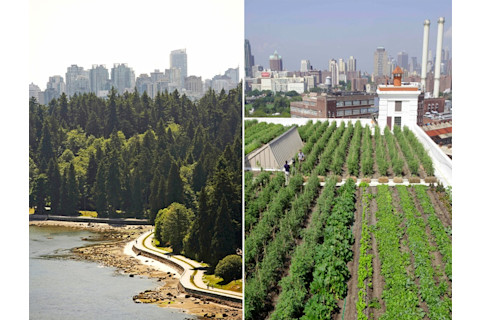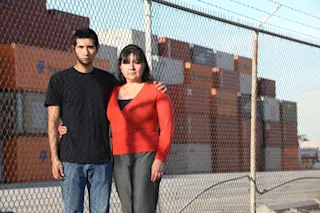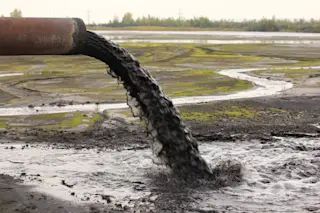Martha Cota awakened one morning to find her infant son, Jose Miguel, gasping for air, his lips and the skin under his fingernails blue from lack of oxygen. Terrified, she rushed him to her local hospital in Long Beach, Calif., where doctors stabilized the toddler and sent him home with medications to control his fever and an inhaler to help him catch his breath. The cycle went on for more than five years — Jose turning blue and barely able to breathe, Cota frantically strapping him into his car seat and racing through traffic, spending countless days and nights sitting in hospital emergency rooms.
Like so many other kids in their working-class neighborhood not far from Long Beach’s massive port, Jose had severe asthma, and it took doctors years to hit on a regimen that controlled his symptoms. “He could have died at any time,” Cota told me, her eyes brimming with tears, when we conversed one April morning through an interpreter at a coffee shop near her office in Long Beach. “At least once a month, I’d get a call from his school threatening to send me to jail because he was absent so much.”
Tall and attired in an elegant black suit, Cota, who is now in her late 40s, has a long mane of dark hair shot through with auburn highlights and large, expressive eyes. She was a social worker in her native Mexico and now works as a community educator for the Long Beach Alliance for Children with Asthma. When she first discovered that many other women and children in her community were having trouble with respiratory illnesses, she was determined to find out why living downwind of the nation’s largest port complex was making so many people sick.
Even at noon on this otherwise sunny day, the sky was blanketed in hazy toxic smog from the ports of Los Angeles and Long Beach, the entry points for more than half of the goods shipped into the United States and the largest source of air pollution in California.
Every day, idling cargo ships carrying 30,000 containers from Asia and the Pacific basin are unloaded by construction cranes towering more than 200 feet high on the docks. Then the containers are dispatched from the rail yards alongside the harbor onto 1,200 diesel-powered freight trains that ferry goods up and down the coast, and 35,000 semi tractor-trailers that speed along heavily congested highways to the rest of the country. Since the 1970s, the massive port complex has exploded to five times its original size, transforming the surrounding area into what one local physician called “an environmental nightmare.”
California may have a reputation as a sun-kissed paradise with some of the world’s most photographed real estate — Southern California’s sparkling white beaches, the celebrated rocky coastline along Big Sur and the epic grandeur of Yosemite and the Sierras. But the reality is that the nation’s most populous state is an industrial colossus — the world’s ninth-largest economy — with the worst air quality in the nation, according to annual report cards issued by the American Lung Association.
The Los Angeles metropolitan area, with nearly two cars per household, has the dubious distinction of having the highest vehicles-per-capita ratio in the world; more than 12 million cars travel on the extensive freeway system every day. But all this commercial activity exacts a heavy toll on residents’ health. The exhaust-filled industrial corridor that stretches from the ports of Los Angeles and Long Beach to Riverside — a city of 300,000 residents and a distribution hub that sprouted up next to the freeways where trucks and trains transporting goods belch dark clouds of diesel dust — is what environmentalists call the “diesel death zone.”
Cota’s first encounter with the environmental cause that would come to consume her life was at a parents’ workshop held at her son’s school, situated about a mile northeast of the waterfront. There, she met a team of physicians connected with the Children’s Environmental Health Center at the University of Southern California who were conducting a long-term study on the link between chronic exposure to air pollution from freeway traffic and respiratory illnesses.
Called the Children’s Health Study, the research project began in 1993 and eventually involved about 5,500 children in 12 communities in Southern California. Two-thirds of them were enrolled as fourth-graders, and all were followed until they graduated from high school. Cota immediately signed up for the study and learned how to use a particle counter, which measures particulates and toxins in the air, to take samples of ambient air quality surrounding her home. “Every time a truck would go by,” she recalled as we sat sipping coffee, “the meter would spike off the charts.” Sometimes it measured 7,000 micrograms of particulate matter per cubic meter, which is more than 400 times the maximum level that federal standards consider healthy.
What the USC researchers ultimately uncovered after a decade of meticulous monitoring was eye-opening. The lung development of children who lived near highly trafficked corridors was stunted — about 20 percent smaller than average — which greatly impaired their functioning. These youngsters also suffered from asthma at significantly higher rates — those living within a quarter of a mile from a freeway had an 89 percent higher risk of asthma than kids more than a mile away.
Their asthma symptoms also were worse, and even among those with health insurance, their odds of ending up in the hospital emergency room choking from the bad air was triple that of youngsters in more affluent areas. Worse yet, pregnant women living in these high-traffic areas were more likely to give birth to premature or low-birth-weight infants, setting up the next generation for a lifetime of disabilities and developmental deficits.
Cota hardly needed a study to tell her this. She and two of her other children later developed severe allergies and now use inhalers and an arsenal of medications just to get through the day. “No one in my family had asthma or allergies,” Cota told me. She started working for the Long Beach Alliance for Children with Asthma, she said, “so no other mother has to put up with what I had to.”
The Other California
The situation is even worse in California’s Central Valley, where a combination of farming, industry, traffic and topography has made the air quality so bad that four regional metropolitan areas rank among the nation’s top 10 dirtiest cities, according to the American Lung Association. Bakersfield, the birthplace of the renegade rockabilly honky-tonk of Merle Haggard and Buck Owens, consistently tops the list.
A long, crescent-shaped lick of fertile flatlands that stretches more than 450 miles and covers 22,000 square miles (slightly smaller than West Virginia), the Central Valley is nestled between the coastal mountains on the west and the Sierra Nevada to the east. They call it “the other California,” with patches of farmland extending as far as the eye can see and hardscrabble towns originally settled by Dust Bowl refugees now covered with strip malls and fast-food outlets. But this high desert region is also home to 6.5 million people — more than the population of two-thirds of the states in the U.S.
The spreading urban sprawl, coupled with industrial growth, has yielded increasingly tainted air. Dairy farm waste, soil blown from farmlands, pesticides, industrial emissions, vehicle exhaust and dust particles kicked up by cars and the big rigs ferrying produce down Interstate 5 and Highway 99 — the valley’s two main arteries — have made this one of the smoggiest places in the nation. The surrounding mountains trap these pollutants, and the stagnant air envelops the region in a perpetual cloud of haze.
On hot days, locals told me, the toxic smog fills hospital emergency rooms and doctors’ offices with children who can’t breathe, and schools in Fresno fly color-coded flags to alert students to the air quality: Green means it’s OK to be outside, while red is a warning to stay indoors. On average, nearly four Central Valley residents die prematurely every day because of the pollution, and experts predict that within the next few years, as temperatures continue to rise and population growth raises smog levels, one of every four children will have asthma.
“In the past 10 years, I’ve had to put more kids on steroids than ever before, which terrifies me,” said Kevin Hamilton, a respiratory therapist and administrator for Clinica Sierra Vista, a string of medical centers throughout the Central Valley that cares for about 50,000 low-income youngsters every year. “It can be overwhelming with patients in every room on inhalers and nebulizers” — the heavy artillery of an asthmatic’s medicinal arsenal. “These kids never get well, and now we have a generation who are permanently damaged by their constant exposure to pollution,” Hamilton, a burly, bearded man in his late 50s, sighed in frustration when we met in his cramped office at the clinic. “The effects are not transient. If they get pneumonia, they’re more prone to end up in the hospital. They can’t participate in athletics, and when they get older, they’re more likely to have heart disease because their bodies can’t generate enough oxygen. They get sicker faster, and die younger.”

More than half of the goods shipped in the United States arrive through the ports of Los Angeles (foreground) and Long Beach (upper right). The port complex is California’s largest source of air pollution. (Noe Montes)
Future Shock
For Californians who live, work and breathe in the state’s industrial zones, the future is already here. The disastrous health effects they experience from pollution are a preview of what will happen everywhere as climate change becomes a routine fact of life, and as the planet gets hotter, carbon levels continue to climb and air quality progressively worsens.
To cite one example, the heat-trapping carbon dioxide emitted from tailpipes and factories collects over cities, creating CO2 “domes” that shroud the urban cores in toxic clouds of pollutants. Research on air quality in New York, Phoenix and Baltimore shows that ambient CO2 parts per million (ppm) levels can spike into the 400s, 500s and 600s, which climate modelers predict will become the norm in 20 to 30 years. Right now, the global average is 393 ppm.
As temperatures rise and more pollutants are dumped into the atmosphere, the plume of that toxic cloud will broaden like ink on a blotter, covering more land under a suffocating carbon canopy. A 2010 Stanford University study found that these domes act like pressure cookers, exacerbating pollution’s harmful health effects, and may already be responsible for up to 1,000 excess deaths across the country, the equivalent of two jumbo jet crashes every single year.
And it will just go from bad to worse in the coming decades, as the Earth gets warmer. Two of the chief culprits behind asthma and allergies — air pollution and smog — will only intensify as the temperatures rise. The result is ozone smog, a toxic brew created as sunlight cooks the mix of pollutants and particles in the atmosphere.
As the air heats up, more ozone is produced. Increasing levels of ozone, in turn, trap more heat, exacerbating the urban heat island effect: Cities are normally about five to 10 degrees hotter than surrounding suburbs because asphalt and cement absorb sunlight, generating a vicious cycle of escalating pollution and heat.
Higher levels of ozone smog, toxic to the lining of the lungs, will also boost the incidence of respiratory diseases. A 2009 study done by European scientists looked at hospital admission data from 12 major cities including Dublin, London, Barcelona, Athens and Rome from at least a three-year period. They found that for every 1-degree Celsius (about 2 degrees Fahrenheit) temperature increase, hospitalizations from respiratory- and asthma-related illnesses rose by 4.5 percent.
Chronic exposure to elevated levels of ozone has a serious cumulative effect. Ozone in the upper atmosphere normally forms a protective layer that shields us from the sun’s ultraviolet radiation. But ground-level ozone — the chemical combustion product of factory and vehicle emissions heated by sunlight — can have a devastating effect.
Sunbelt cities like Los Angeles, Riverside, Calif., and Houston, with their seemingly endless sunny days, gridlocked urban sprawl and heat-trapping stagnant air masses, contain the highest average concentrations of ozone, according to a 2009 study by University of California, Berkeley scientists. People living in these regions, and in California’s Central Valley, have a 25 to 30 percent greater annual risk of dying from respiratory diseases like pneumonia and chronic obstructive pulmonary disease than do residents who enjoy cleaner air in places like San Francisco and Seattle, where fog, rain and cooler temperatures keep ozone levels in check.
In much of California, on the other hand, a witches’ brew of pollutants cooked in the atmosphere can sear the delicate tissue lining the lungs and aggravate an astonishing array of other health problems, ranging from heart disease and lung cancer to dementia. The dirty particles accelerate the thickening of arteries, which, in turn, increases the chances of heart attack and stroke and accelerates a decline in cognitive abilities because less oxygen-rich blood is being pumped to the brain.
One 2012 study that followed nearly 20,000 women nationwide revealed that exposure to this type of pollutant greatly speeds memory impairment and reduces concentration. And women who experienced higher levels of exposure to tainted air for longer periods of time had “significantly” sharper declines in mental acuity, the equivalent of an extra two years of aging.
“The same chemical reaction that makes more ozone and goes faster when temperatures are higher also produces chemical compounds that make particles, or particulate matter, in the air,” said Anthony Wexler, director of the Air Quality Research Center at the University of California, Davis.
Big particulate matter — PM10 — is about 10 microns, similar to the thickness of a strand of hair. Typically, these particles are found in windblown or construction dust and are emitted by woodstoves, fireplaces, trash incinerators and wildfires. PM10 particles tend to make up that thick blanket of haze that envelops urban areas, and when inhaled, they stick to the insides of the lungs’ small branches that transport oxygen to the gas-exchanging tiny sacs called alveoli.
The alveoli are surrounded by thick networks of blood vessels. This is where the crucial switch is made and our bodies perform their miraculous life-sustaining alchemy: Carbon is removed from the blood to be expelled from the lungs and replaced by fresh oxygen, which is then pumped to the heart for circulation. But the pollutants cause the lungs to make mucus, trapping these particles, and creating a persistent cough.
Finer particles, at 2.5 microns (PM2.5) or less, are some 30 times smaller than the width of a human hair — and invisible to the naked eye. These tiny bits are found in the smoke and soot from brush fires, heavy metals and toxic chemical fumes. And research has consistently shown that PM2.5 particles are far more toxic and deadly than the larger particles because they can evade the respiratory system’s natural defenses.
In California, exposure to these fine air particles is associated with up to 24,000 deaths every year, according to a 2009 study by the California Air Resources Board, the majority of them in highly populated areas such as the San Francisco Bay, the San Joaquin Valley and the Los Angeles air basins. PM2.5 particles penetrate deep inside the lungs, causing constant irritation that diminishes lung capacity and can lead to cancer. Like PM10 particles, they insinuate themselves inside the walls of blood vessels, which can trigger the formation of the artery-clogging plaques that are the culprits behind strokes and heart attacks. There is evidence that even smaller particles, which are 100 nanometers, can infiltrate the brain through the nasal passages, potentially eroding cognitive abilities.
“What we’re seeing now is probably just the beginning of the effects we’ll experience from bad air,” Jose Joseph, a pulmonologist and asthma specialist at the Fresno campus of the University of California, San Francisco, told me rather ruefully one steamy October afternoon when I visited his tidy office at the university’s medical center. “In the years to come, we’re going to have major increases in all types of chronic illnesses,” he continued, ticking them off on his fingers, “in respiratory illnesses, in heart disease, in increases in heart attacks and strokes because air pollution increases blood clotting, and in its effects on developing fetuses — there is so much fallout from air pollution. In looking at the magnitude of the problem, we really have to do better than this.”
Simple Justice
But there is some good news: Even seemingly small changes in curbing greenhouse gas emissions not only can reduce harmful pollutants and clear the air, but also help to slow climate change. In California, local grassroots groups have been successful in pushing polluters to clean up their communities and compelling government agencies to protect residents from the consequences of a warming planet.
They’re part of the environmental justice movement, a crusade that grew out of the recognition that it was mainly the poor and people of color who were forced — by circumstance, finances, lack of political power and what activists call “environmental apartheid” that callously targets the disenfranchised — to live and work in some of the nation’s dirtiest environments.
Luis Cabrales, who worked for many years as a campaign director for the Coalition for Clean Air, a venerable green group that was instrumental in the passage of California’s historic vehicle Smog Check Program in the early 1970s, has spent most of his adult life fighting for environmental justice. A slight man with a full head of dark hair, a square jaw and the broad-shouldered build of a wrestler, Cabrales possesses the easygoing charm and dogged persistence of a natural-born organizer.
There have long been strands of environmentalism in the civil rights struggle, Cabrales tells me during an interview in the coalition’s offices in a high-rise in downtown Los Angeles. Rosa Parks’ refusal to move to the back of the bus stemmed from a deep need for adequate public transportation, he points out, while César Chávez pushed to protect farmworkers from the harmful pesticides that were killing them in California’s Central Valley.
But it wasn’t until the late 1970s when people started connecting the dots and realized that African-Americans resisting attempts to establish garbage dumps in their neighborhoods were essentially fighting the same fight as grassroots activists protecting endangered species. “Better housing, clean water, clean air, safe schools,” said Cabrales, “these all had to do with the environment.”
In the decades since, the environmental justice movement has grown from a scrappy army of the poor and disenfranchised into a powerful coalition that united the mostly white and college-educated traditional environmentalists, trade unionists, blue-collar workers and residents of some of the nation’s most contaminated neighborhoods. It has used its growing political clout and numbers to take its place in the corridors of power.
“We’ve changed the paradigm into a green-blue coalition,” said Cabrales. “Years of environmental consciousness-raising are really bearing fruit, and environmentalists are no longer seen as weed-smoking, sandal-wearing tree huggers. Over the last 10 years, the change has been dramatic because a new generation of environmental advocates now hold positions of power in the legislature, on the ports commission and on the air resources board.”
It is a remarkable sea change that has seen someone like Fabian Núñez of East Los Angeles, one of 12 children born to a gardener and a maid from Tijuana, ascend to the speakership of the California Assembly and co-author of the nation’s most stringent measures to alleviate global warming. The landmark package of laws is considered former governor Arnold Schwarzenegger’s signature legislation and has become a model for the rest of the world.
“He was a gardener when he was a kid and pushed around a lawn mower helping his dad,” said Cabrales, with no small measure of pride. “Now he’s helped create the strongest pollution-control standards in the world — a Mexican immigrant.”
In the past decade, the Coalition for Clean Air has waged a successful campaign to begin cleaning up the deadly diesel pollution emanating from California ports. Working in tandem with such groups as the Natural Resources Defense Council and the Coalition for a Safe Environment, along with the Teamsters and Longshoremen’s unions and local activists like Martha Cota, they’ve done extensive lobbying in Sacramento and community organizing to push for enforcement of the California Environmental Quality Act and compel the Port of Los Angeles to initiate a suite of pollution-reduction strategies that have cleaned up the air.
These included the Clean Truck Program, which replaced the port’s fleet of old, dirty diesel trucks with EPA-compliant vehicles equipped with particle filters, and electrifying the ports so ships can just plug in to power their infrastructure while at the dock. A single ship idling in the port — they normally sit at anchor for two to three days while they’re being unloaded — emits more pollution than five diesel school buses in an entire year.
Turning off the engines and using electrical power can cut as much as three tons of smog-inducing emissions from each ship. Still, while pollution at the Port of Los Angeles has been reduced by about 70 percent from its height, air quality remains a serious problem. “But at least we’ve made a start,” said Cabrales, and, he added, flashing a toothy smile, “we now have a seat at the table.”
[This article originally appeared in print as “Breathless” and is excerpted from FEVERED: How a Hotter Planet Will Hurt Our Health And How We Can Save Ourselves by Linda Marsa. Copyright © 2013 by Linda Marsa. Excerpted by arrangement with Rodale Inc."]
Creating Sustainable Cities

Stanley Park, Vancouver (left) and a rooftop garden in Brooklyn (right). (Thinkstock; Seth Wenig/AP/Corbis)
Two of the greenest cities in North America, New York and Vancouver, have hit upon the right recipe for a more sustainable 21st century, and they are investing in infrastructure changes to prepare for the new realities of a hotter world.
Vancouver: Pedestrian Paradise
Vancouver, British Columbia, is North America’s uncontested leader in smart growth and is consistently ranked among the world’s most livable cities. Among Northwestern cities, the Canadian metropolis, which is home to more than 2.3 million residents, has the highest population density; the greatest rates of cycling, walking and transit riding; and the fewest cars per capita, plus the highest life expectancy, lowest teen birth rate and lowest poverty rate.
Vancouver also leads the world in the use of hydroelectric power, which makes up 90 percent of its energy supply, and regularly uses renewables like wind and solar. Its pedestrian-friendly, high-density neighborhoods (14,000 people per square mile) are clustered around high-rises, multifamily dwellings, restaurants, groceries, shops and pocket parks, and have wide sidewalks that encourage walking and short blocks that slow traffic.
The extensive mass-transit system eases traffic congestion and includes high-capacity diesel buses and electric trolleys, a network of light-rail routes and an elevated train service called SkyTrain. There are hundreds of miles of biking trails. Because of all of these factors, Vancouver has the lowest per-capita carbon emissions of any major city in the Western Hemisphere.
In the future, Vancouver wants to become not just the greenest, but the world’s most sustainable city. The city’s action plan focuses on even greater use of renewal energy, further upgrades to the existing transportation system and expansion of the city’s already considerable green space, including the world-class Stanley Park, which is larger than Central Park.
The blueprint also encourages urban agriculture, rethinks sewer and wastewater management and reduces greenhouse gas emissions per capita to the lowest in the world by promoting even higher-density living with smaller multifamily homes, especially along transit corridors in Vancouver’s downtown peninsula.
New York: Land of a Million Trees
On Earth Day 2007, New York Mayor Michael Bloomberg unveiled PlaNYC, a comprehensive, 127-point blueprint to create a sustainable city. It involves initiatives to revitalize the city’s 580 miles of waterfront, decrease energy costs, cut greenhouse gas emissions by 30 percent by 2030 and upgrade the infrastructure to prevent shorelines from being swamped by flooding and storm surges.
After Superstorm Sandy, long-gestating plans to build three massive surge barriers have been moved to the front burner, along with discussions about raising entrances to flood-prone subway stations and the locations of critical equipment like pumps, transformers and wastewater pipes.
Heavy downpours can overwhelm New York’s antiquated 19th-century sewer systems, the miles of pipes and tunnels that carry away wastewater and, when overtaxed, divert billions of gallons of raw sewage and contaminated urban runoff into the rivers, lakes and the ocean. The city has committed $1.5 billion to erecting green infrastructure — green roofs, street and sidewalk plantings, porous pavements, cisterns, rain barrels — that will control and absorb storm water and prevent polluted runoff from flowing into waterways by capturing it and filtering it naturally through the soil.
The city has also launched several programs to turn down the climate’s thermostat, such as the Million Trees project (more than half a million have already been planted around the city) and painting flat roofs with a white or “cool” coating that reflects the sun’s energy. More than 2 million square feet of roofs have been covered so far, with the goal of coating them all by 2030.
New York is also an acknowledged world leader in its efforts to create a more sustainable food system. A broad-based coalition of neighborhood activists, social justice and food advocacy groups, top chefs, writers, farmers, fishermen, ranchers, civic leaders and state agencies is revamping the way food is grown, distributed and disposed.
The improvements include ways to preserve and promote regional farming and food production; connect rural farmers with city markets; cultivate urban agriculture; create large-scale municipal composting facilities; and expand food cooperatives and outreach programs to residents in low-income areas, especially through school food and afterschool programs.














